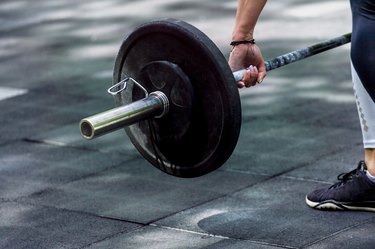
The calories burned in a deadlift can depend on a number of factors, such as the type of lift, your weight and how intense you choose to lift. Anyone who adds this challenging movement to their weightlifting regimen could get rewarded with better overall power and stronger legs.
Video of the Day
Video of the Day
Calories Burned in a Deadlift
Counting calories is one method of weight loss, which you can track using a calorie calculator app. However, knowing exactly how many calories you burn doing a specific activity is difficult. For example, according to Harvard Health Publishing, a 125-pound person burns about 90 calories weightlifting for 30 minutes, but that calorie count goes up the more you weigh.
The number of calories you burn performing deadlifts can depend on more factors than just weight:
Type of deadlift. A straight-leg deadlift is a single-joint exercise; you move at the hip joint. A standard deadlift is a multi-joint exercise; you move at the hip and knee joints. Because you use more muscle groups during a standard deadlift, you can use more weight. Lifting more weight and using more muscle groups means you burn more calories doing the standard deadlift than a straight-leg deadlift.
Your weight. Although the logic may seem counterintuitive, you burn more calories the more you weigh. If you weigh 220 pounds, do a strength workout and then do the same workout when you weigh 180 — with all other factors staying the same — you would burn more calories the first time because you are moving more weight through space.
Your metabolism. The amount of calories you expend during a deadlifting session is not the total number of calories you burn as a result of your session. EPOC, or excess post-exercise oxygen consumption, is the amount of calories your body burns after a strength-training workout to return your body to its previous state, according to the American Council on Exercise. Your body has to restore oxygen levels, remove lactic acid buildup and create new energy stores, among other processes.
Intensity of your deadlifts. The more intense your workout, the more calories you burn. Using more weight for the deadlift and reducing your rest time between sets increases intensity.
Benefits of Deadlifts
Performing deadlifts can enhance your health and fitness by strengthening your musculoskeletal structure, lowering body fat and elevating your lean body mass. The move also benefits specific sports enthusiasts, such as the following:
Valuable for downhill runners, cyclists and skiers. In a July 2017 study published in BMC Sports Science, Medicine and Rehabilitation, deadlifts were found to result in the highest loading for the quadriceps when compared to good mornings and split squats. Deadlifts also produced increasingly large loading over significant ranges of motion in knees and hips — helpful for sports that rely heavily on the quad muscles.
Assists in muscle development for sports that require quick bouts of power, such as football and baseball. According to an April 2018 review published in MOJ Yoga & Physical Therapy, the deadlift mechanics possess a favorable ability to recruit muscle groups and allow for continued acceleration — all vital for power development.
Might be more helpful than the squat for long jumpers. An August 2018 review from the_ Journal of Yoga and Physiotherapy_ states that, because in a deadlift the load is applied perpendicular to the body and loaded in a horizontal plane (unlike the squat), this movement could be more beneficial to horizontal-based sports.
To properly execute a deadlift, the National Strength and Conditioning Association, in an April 2014 report, provides key tips:
- Keep your head looking slightly up.
- Engage your lats first.
- Try to push your knees apart.
- Focus on the position that is weakest for long-term improvement.
- Journal of Yoga and Physiotherapy: “The Deadlift – Part 1”
- MOJ Yoga & Physical Therapy: “The Health and Performance Benefits of the Squat, Deadlift, and Bench Press”
- National Strength and Conditioning Association: “The Deadlift and Its Application to Overall Performance”
- BMC Sports Science, Medicine and Rehabilitation: “Towards Evidence Based Strength Training: a Comparison of Muscle Forces During Deadlifts, Goodmornings and Split Squats”
- American Council on Exercise: "7 Things to Know About Excess Post-exercise Oxygen Consumption (EPOC)"
- Harvard Health Publishing: "Calories Burned in 30 minutes for People of Three Different Weights"